Curing Potential and Color Stability of Different Resin-Based Luting Materials
Abstract
Purpose. To determine the curing potential and color stability of resin-based luting materials for aesthetic restorations. You have the opportunity to gather more in-depth information about composite materials and working protocols on our website in Direct Restoration section.
Material and Methods. Four resin-based luting agents were tested: traditional dual-activated resin cement (RelyX ARC, ARC), amine-free dual-activated resin cement (RelyX Ultimate, ULT), light-activated resin cement (RelyX Veneer, VEN), and pre-heated restorative resin composite (Filtek Supreme, PHC). Degree of C=C conversion was determined by infrared spectroscopy (n= 3) with direct light exposure or with interposition of 1.5-mm-thick ceramic (e.max Press HT) between the luting material and light. The curing potential considered the ratio between these two scenarios. Color difference (n= 6) was determined by CIELAB (ΔEab) and CIEDE2000 (ΔE00) methods, by spectrophotometer measurements made 24h after photoactivation and 90 days after storage in water. Data was submitted to ANOVA and Tukey’s test (α= 0.05).
Results. The luting agents affected both conversion and color stability. With ceramic, ARC produced the highest conversion among the tested groups (75 ± 1%) and the pre-heated composite (PHC) the lowest one (51 ± 3%), but the curing potential was similar for all materials. ULT produced lower ΔEab than ARC. PHC presented the lowest color difference when considered both CIELAB and CIE2000 methods (ΔEab 2.1 ± 0.4; ΔE00 1.6 ± 0.2).
Significance. All luting strategies presented high curing potential. Amine-free dual-activated material was able to reduce color difference than that formulated with the amine component. Pre-heated composite produced the least color variation after storage.
1. Introduction
Ceramic-based restorations have been widely used for oral rehabilitations due the adhesive possibilities, physicochemical stability, and ultimate aesthetics [1–3]. Luting agents with improved color stability are desired for longevity and avoiding premature failure due to aesthetic reasons.
Resin-based cements have successfully been used for luting purposes and the light-activation mechanism depends on the possibility of light transmission through the prosthetic pieces [4,5]. For many years, dual-activated resin-based cements were the main choice especially due to the low irradiance of the first light-curing units available. With the increased demand for aesthetic treatments, dual-cure cements lost space because their high content of amine-based co-initiators might induce accentuated discoloration by oxidation processes [6]. Researchers and manufacturers have aimed alternative formulations and some companies introduced amine-free resin cements, but only few studies have provided evidence for improved color stability [7,8]. The use of ceramic laminate veneers has gained popularity for anterior aesthetic restorations as well as for increase in dimension of vertical occlusion in posterior teeth [9,10]. Light-activated cements, also known as veneer cements, are generally used for their wide range of shades and allowing color-matching tests with try in pastes [11,12]. Another approach is the use of pre-heated restorative resin-based composites, also known as pre-warmed or thermally-modified composites. Their filler content is usually higher than resin cements, and thus show improved mechanical properties [2,13]. The use of pre-heated resin composite could also enhance color stability, but the evidence is scarce [6]. Additionally, there is low evidence about the curing potential of such strategy. As it can be seen, analyses of amine-free, dual-activated cements and pre-heated composites considering color stability and curing ability are warranted to ensure good clinical indication.
The aim of this study was to investigate the curing potential and Eab of different luting strategies for aesthetic restorations. The research hypotheses were that: a) dual-activated resin cements would present better curing potential under ceramic restoration than light-activated resin cements; b) the amine-free resin cement and pre-heated restorative resin composite would be advantageous in terms of color stability.
2. Material and methods
2.1. Experimental design
The presentinvestigation considered distinctfactorial designs to determine the curing potential and color stability of different materials used for luting aesthetic restorations. For curing potential, a 4 × 2 design had luting agent (four levels) and ceramic interposition (two levels: yes/no) as factors, and degree of C=C conversion (DC) as response variable (n= 3). A separate analysis of curing potential was carried out for the restorative resin composite at room temperature (25 ± 1 ◦C) with direct light exposure (n= 3). For color stability, a 4 × 2 design was used with luting agent (four levels) and storage (24h or 90 days in water) as factors, color coordinates and color difference as response variables (n= 6). Sample size estimation considered previous published articles with similar methods [14,15].
2.2. Materials tested
The resin luting agents analyzed were: two dual-activated resin cements (one conventional amine-based, one aminefree), a light-activated resin cement, and a pre-heated restorative resin composite. The composition of each material is described in Table 1. All luting agents tested were shade A1 or A1 enamel shade (A1E). All materials were from the same manufacturer to limit variations in formulation.
The two dual-activated resin cements were used in a similar way: two doses were dispensed in a mixing plate from their clicker syringes, which allow to controlthe amount of material used. The materials were then mixed with a plastic spatula. The veneer cement was used directly from the syringe, as recommended by the manufacturer. The resin composite is indicated for restorative procedures, thus it was inserted into a compule attached to a dispenser syringe (DFL, Rio de Janeiro, RJ, Brazil) and placed in a laboratory oven at 68 ± 1 ◦C for 30min to reduce the viscosity. Later the entire set was taken and the material injected into the molds used for each test and covered with a Mylar strip. Excesses were removed and photoactivation was carried as following detailed. Interposition of a lithium disilicate ceramic disk (1.5mm thickness, 10mm diameter) between the luting agents and light guide was carried out to simulate an indirect restoration (e.max Press HT shade A2; Ivoclar Vivadent, Schaan, Liechten- stein). The ceramic disk was sintered and polished following the manufacturer’s recommendations.
One LED-based light curing unit (LCU) was used for all the photoactivation procedures (Bluephase G2; Ivoclar Vivadent, Schaan, Liechtenstein). The LCU was used in its cord-based power supply mode to assure constant irradiance during the experiments. The diameter of the light curing unit at tip was measured with a digital caliper (Digimatic Caliper 0.01-150mm; Mitutoyo, Kawasaki, Japan) to calculate the effective light guide tip area in cm2. The power (mW) was measured with a power meter (10A-V2-SH; Ophir Optronics; Jerusalem, Israel) connected to a microprocessor (Ophir Optronics). Mea- surements were performed with the light guide tip in contact with the power meter sensor and with interposition of the ceramic disk. Light irradiance (mW/cm2) was determined by the ratio between power and area. Additional readings were done with the Mylar strip between the light guide tip and the ceramic disk, but the difference was irrelevant.
Table 1 – Resin-based luting agents used in the study. All products were from the same manufacturer (3M, St Paul, USA).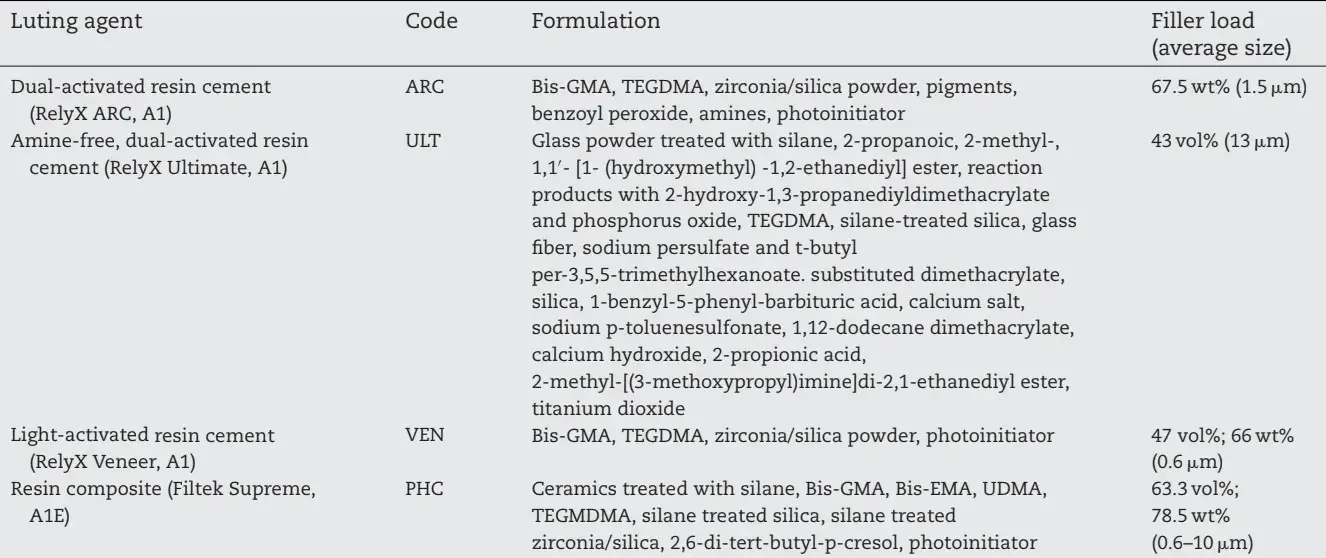
2.3. Degree of C = C conversion
The DC was determined by Fourier-transformed infrared spectroscopy (n= 3), using a spectrometer equipped with an attenuated total reflectance (ATR) diamond device (FTIR; Brüker Optics, Ettlingen, Germany). A dark circular plastic mold (diameter 7mm, thickness 0.05mm) was used for individual accommodation of each luting agent over the ATR crystal, and to avoid light reflection and consequent overexposure to light. A Mylar strip was placed on the surface, which was made flat by pressing down with the ceramic disk. A spectrum from the uncured material was taken in the absorbance mode using 32 scans and 4 cm−1 resolution. The ceramic disk was positioned on top of the mold and photoactivation was carried outfor 40 s. A second spectrum (polymer) was obtained after 5min. %DC was calculated using baseline technique and considering the differences in intensity of C=C stretching vibration (peak area) at 1638 cm−1 of uncured and cured spectra, with the symmetric aromatic stretching at 1608 cm−1 (peak area) as internal standard. The following formula was used:
In order to determine the effect of the light attenuation on DC, a second series was performed without interposition of the ceramic disk. The curing potential considered the ratio between these two scenarios. In addition, a separate analysis was carried out with the resin composite without ceramic interposition at room temperature. This analysis was done to determine if an eventual C=C conversion decrease under ceramic disk was due to light attenuation only or also an effect of temperature decrease caused by contact with ceramic.
2.4. Color stability
Disk-shaped specimens (n= 6) were obtained with a rubber-based mold (0.5mm thickness, 10mm diameter) and photoactivation for 40 s from the top surface with the ceramic interposition. The specimens were stored in distilled water in the dark for 24h at room temperature, when baseline color measurements were made. A digital spectrophotometer (CM-2600D; Konica Minolta, Tokyo, Japan) was used to measure individual color coordinates (L*, a*, b*, h’, and C’) of each specimen. The background was a standard, bovine tooth that was embedded in epoxy-based resin, flattened, and polished to expose medium dentin. All readings were performed with glycerin-based gel between the ceramic and the luting agent and also between the luting material and the background. All specimens were then stored in distilled water for 90 days in the dark at room temperature, with water changed every week. Color measurements were made again and the color difference was calculated by the CIELAB (ΔEab) [16] and CIEDE2000 (ΔE00) [17] formulas:
considering: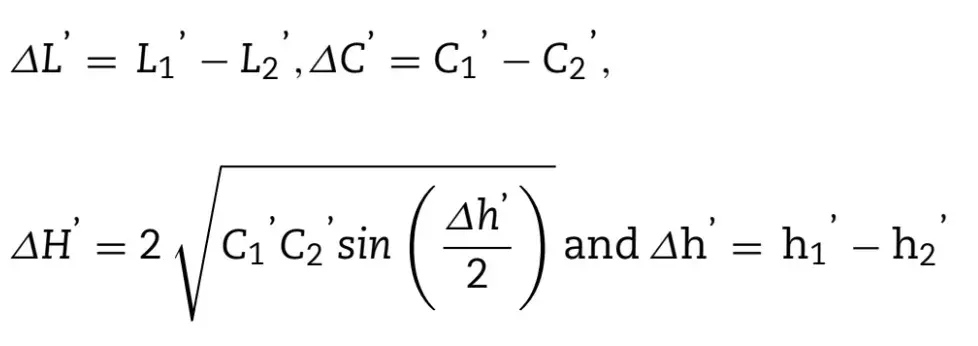
where L, C and H are the mathematical differences in lightness, chroma, and hue between two different measurement periods and RT (rotation term) is a function that accounts for the interaction between chroma and hue differences in the blue region and for dental color space, it is close to zero [18]. KLSL, KCSC, and KHSH are empirical terms used for weighting the metric differences to the CIEDE2000 differences for each coordinate. Parametric factors were setto KL = 2, KC = 1, and KH = 1 according to the better performance of the ΔE00 equation [18,19].
2.5. Statistical analysis
Normality and equal variance were confirmed. Data for DC and color coordinates (L*, a*, b*) were analyzed using two-way Analysis of Variance (ANOVA) followed by the Tukey’s method for pairwise multiple comparison procedures (α = 0.05). way analysis of variance and Tukey’s tests were used for color difference data (α = 0.05).
3. Results
The calculated irradiance of the curing unit with direct light exposure was 1218mW/cm2, ceramic interposition reduced it to 692mW/cm2, i.e. 57% of the original condition. The ANOVA revealed that both factors luting agent (p < 0.001) and ceramic interposition (p < 0.001) significantly affected the degree of conversion. The interaction between factors was not significant (p = 0.051).
Table 2 presents %DC of the luting agents activated with and without interposition of ceramic. With ceramic interposition, the highest DC was observed for the traditional dual-activated resin cement (ARC) and the lowest value with the pre-heated composite (PHC). Intermediate values were obtained by the amine-free dual-activated (ULT) and veneer (VEN) resin cements.
Considering the difference between the average values obtained in each of the two scenarios (with and without ceramic interposition), it is possible to describe that all resin cements presented curing potential over 90% after ceramic interposition, but the pre-heated composite only 76.8% when considering the warmed composite with direct exposure to light as the maximum conversion reference (Table 2). However, the curing potential of the pre-heated composite used under the ceramic was 97.5% of the conversion obtained with the composite at room temperature and directly exposed to light (Table 3).
Table 4 presents the results for L* (lightness), a* (red to green axis), and of b* (yellow to blue axis) before and after the storage process. The factors luting agent (p < 0.001) and storage (p < 0.001), as well as their interaction (p = 0.001), significantly affected L*. No significant difference was observed Fig. 1 – Mean values, and standard deviation, of lightness variations’ (ΔL). Pre-heated composite (PHC) presented the lower variation than the dual-activated (ARC), the amine-free (ULT) and the light-activated (VEN) resin-based cements. among the luting agents before storage. However, after the storage in water, the pre-heated composite presented lower L* than the other materials, which showed similar results. Except for the pre-heated composite, water storage increased L* for all materials analyzed. Fig. 1 presents the comparison between the average values obtained for the variation of luminosity for each sample before and after the storage process in water and it is evident that the pre-heated composite produced the lowest variation.
Luting agent (p < 0.001) was the only factor influencing a* results, while the factor storage (p = 0.620) and the interaction between factors were not significant (p = 0.229). The regular and amine-free dual-activated agents had significantly higher a* (more reddish) than light-activated luting agents. Fig. 2 shows the mean values of a * variation (Δa), where there was no difference among the tested groups. For b*, both luting agent (p < 0.001) and storage (p < 0.001) factors were significant, as well was their interaction (p = 0.005). The regular dual-activated resin cement showed greater intensity in yellow degree (higher b* values) than the other luting agents before water storage. After storage, all materials presented a reduction b* and VEN presented significantly lower b* than the other luting agents. Fig. 3 shows the mean values of b* variation (Δb), where the veneer cement promoted the greatest variation and the amine-free dual cement and the regular composite the lowest.
Color changes according to CIELAB and CIEDE2000 methods are also presented in Table 4. When considered CIELAB, the pre-heated resin composite had significantly less color change than all other resin luting agents. When CIE2000 was considered, the pre-heated resin composite and the amine free resin cement produced statistically lower color change than the others. On the opposite, the regular dual-activated cement showed significantly higher color change than the other materials regardless of the criteria used for the evaluation.
Table 2 – Means for C=C conversion of the luting agents photoactivated with and without interposition of ceramic.
Table 3 – Degree of C=C conversion for the resin composite activated in different scenarios.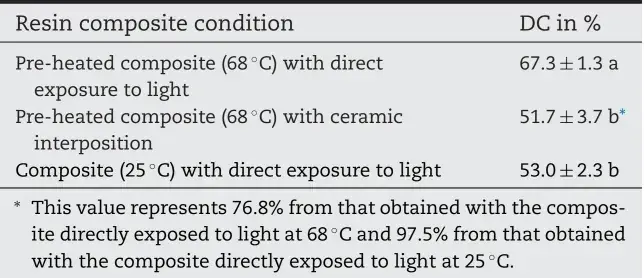
Table 4 – Means ± standard deviations of CIE L*, a*, and b* parameters and color difference calculations according to CIELAB (ΔEab) and CIEDE2000 (ΔE00) methods.
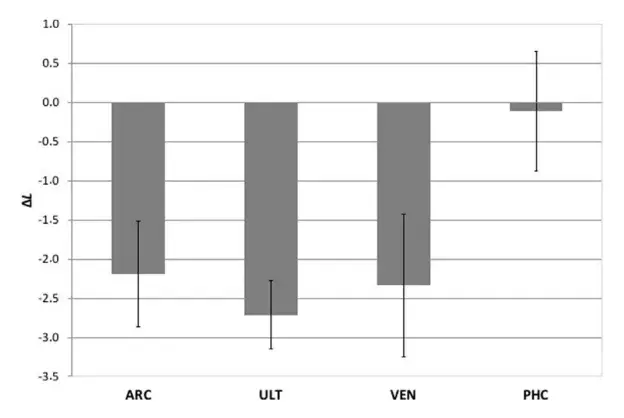 Fig. 1 – Mean values, and standard deviation, of lightness variations’ (ΔL). Pre-heated composite (PHC) presented the lower variation than the dual-activated (ARC), the amine-free (ULT) and the light-activated (VEN) resin-based cements.
Fig. 1 – Mean values, and standard deviation, of lightness variations’ (ΔL). Pre-heated composite (PHC) presented the lower variation than the dual-activated (ARC), the amine-free (ULT) and the light-activated (VEN) resin-based cements.
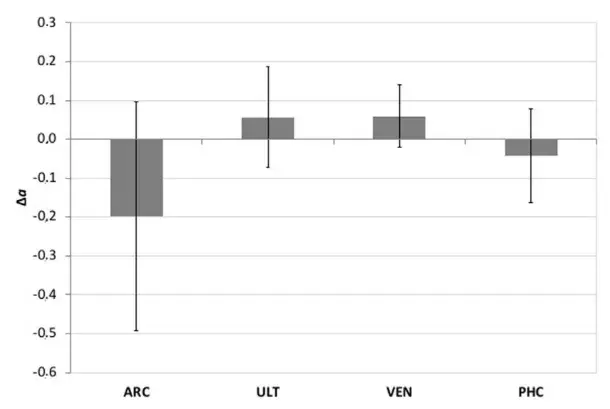 Fig. 2 – Mean values, and standard deviation, of Δa.
Fig. 2 – Mean values, and standard deviation, of Δa.
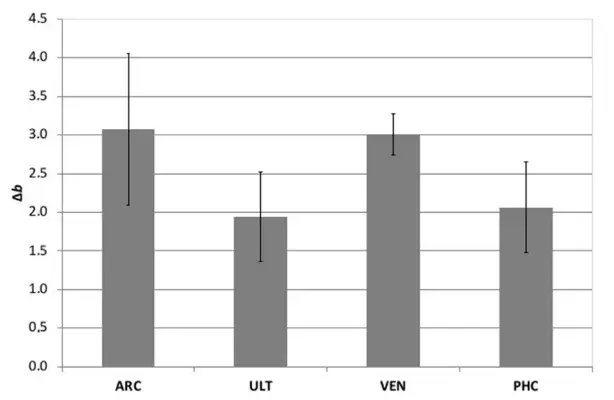 Fig. 3 – Mean values, and standard deviation, of Δb. Pre-heated composite (PHC) and amine-free dual-activated resin-based cement (ULT) presented lower variations than the dual (ARC) and the light-activated (VEN) resin cements.
Fig. 3 – Mean values, and standard deviation, of Δb. Pre-heated composite (PHC) and amine-free dual-activated resin-based cement (ULT) presented lower variations than the dual (ARC) and the light-activated (VEN) resin cements.
4. Discussion
The degree of C=C conversion is directly associated with the final properties of polymer-based materials but a simplistic comparison of absolute values has to be cautious when dealing with distinct materials with varied formulations as does not consider the three-dimensional arrangement of the polymeric structure [20]. As the current research focus luting agents, that need to be activated trough prosthetic components, the curing potential was considered.
Pre-heated composite was the most affected material by the ceramic interposition when considering the ratio between the DC obtained with the heated composite directly exposed to light and the DC when the material was under the ceramic. Besides light scattering the lower C=C conversion could also be related to loss of heat caused by the luting agent contact with the ATR crystal and the ceramic disk that were at room temperature. It is important to mention that the time elapsed between the removal of the heater assembly, application into the molds, positioning ofthe Mylar stripe and the ceramic disk took about 90 s. Similar behavior was found in a previous study [21]; thus, an isolated reading was carried out and the material was also tested at room temperature and directly activated by light. The outcome indicates that the obtained value is like thatin which the material is heated and placed under ceramic, signing that the large drop in conversion occurs mainly due to loss of temperature, the consequent increase in viscosity and the reduced monomer mobility. If at first this can be considered a disadvantage, it is important to highlight that the main reason for heating the restorative composite is to reduce its viscosity and allow it to flow when seating an indirect restoration, not to increase its DC. After the restoration is seated, the composite cools down and excesses are removed. For this reason, a separate DC analysis was performed (Table 3), in which the resin composite was directly photoactivated without being pre-heated. In this scenario, the polymerization potential of the photoactivated material through ceramic was 97.5% as compared when the resin was exposed directly to light. Thus, the material actually showed a great polymerization potential and the first research hypothesis was rejected as the curing potential of all materials was above 90%. It is also important to remember that only lithium disilicate-based ceramics were tested in the current study and that similar behavior could not be expected when other ceramic types or even indirect composites are used.
Although the present work does not involve precise analysis of materials’ rheology the viscosity of the pre-heated composite was clearly superior to the other materials during manipulation. Filtek Supreme was selected in order to keep the same brand as the resin cements used in the currentinvestigation, but Al-Ahdal et al. demonstrated that this material has lower ability to flow than other regular resin composites when exposed to heat [22]. Additionally, Sampaio et al. found that the film thickness may be negatively influenced when the same material is used with the pre-heating technique [11]. Due to all the aforementioned facts, additional studies are warranted testing other regular composites brands in the pre-heating technique [14].
The second hypothesis was accepted, as the preheated composite and the amine-free dual-activated cement achieved higher color stability than the traditional-dualactivated and veneer cements. The analysis of color difference is a complex process and must consider different parameters involved [12]. The degree of luminosity did not differ among the luting agents before storage in water. In contrast,there was a significant increase in L* after water storage for all the resin cements but not for the pre-heated composite. This behavior is probably associated with the higher content of inorganic filler particles and the presence of more rigid, less hydrophilic, monomers than the resin cements [23]. Since the manufacturer does not provide the volumetric percentage of fillers for RelyX ARC or the weight percentage for RelyX Ultimate, it was not possible to perform a correlation test between the materials’ filler content and Eab. However, the differences in the inorganic content for these restorative materials are clear (Table 1).
The dual-activated materials presented higher intensity of red than materials exclusively activated by light. Based on the information provided by the manufacturer it is not possible to precisely state the cause of this finding. Within normality, the light emitted at greater wavelength has smaller scattering and greater energy than that of smaller wavelength and it could be speculated that specific reddish components capable of absorbing light at higher wavelengths could be used as a way to take advantage of the greater transmitted irradiance in this area of the visible spectrum through of ceramic parts [15]. In other words, reddish components could be used to absorb light in the far blue, close to the green, spectra. However, the differences observed could also merely be a consequence of fine adjustments of pigments in the formulations.
Considering the results obtained for the b* axis before storage, the degree of yellow of the dual-activated cement containing amine (ARC) was higher than the other materials, that is a probable consequence of the high concentration of photoinitiator and amines required to react both with the camphorquinone-based photoinitiator and the benzoyl peroxide-based redox activator [24]. After storage in water, the degree of yellow was reduced for all materials, which is likely a result from leaching of unreacted polymerization promoters [25]. The monomeric system also plays an important role on the Eab of dental composites [20]. Leaching of residual monomers and additives [26] could also be associated with yellowing reduction. The lowest variations in degree of yellow were observed for the amine-free dual-activated cement and pre-heated composite.
Pre-heated composite promoted the lowest color difference among the materials tested as a consequence of the lowest variations in the L* and b*, probably resultant from low water absorption and solubility. In this sense, it is important to point out that one limitation is that present study considered the storage by complete immersion of the specimens in distilled water. Thus, because they are not adhered to the dental structure as well as to prosthetic parts,the contact area in which the luting agent is exposed to the storage medium exceeds that normally observed in clinical situation. Further limitations are that the DC was monitored for only 5min after light-activation, and post-cure could have a compensatory effect [27]. Also, data obtained for a given brand cannot be extrapolated for an entire material’s category. Therefore, laboratory studies are also welcome with other brands.
5. Conclusion
Within the limitations of this in vitro study, the following conclusions can be drawn:
all the tested materials presented high curing potential for luting purposes;
the pre-heated composite presented the highest color stability.
Further details about aesthetic protocols of composite restorations are accessible for you to learn on our course "International schools working with composite restorations".
List of authors:
Luis Felipe J. Schneider, Robson Barroso Ribeiro, Walleska Feijó Liberato, Vinícius Esteves Salgado, Rafael R. Moraes, Larissa Maria Cavalcante
References
Layton DM, Clarke M. A systematic review and meta-analysis of the survival of feldspathic porcelain veneers over 5 and 10 years. Int J Prosthodont 2013;26:111–24.
Gresnigt MM, Kalk W, Özcan M. Clinical longevity of ceramic laminate veneers bonded to teeth with and without existing composite restorations up to 40 months. Clin Oral Investig 2013;17:823–32.
Sasse M, Krummel A, Klosa K, Kern M. Influence of restoration thickness and dental bonding surface on the fracture resistance of full-coverage occlusal veneers made from lithium disilicate ceramic. Dent Mater 2015;31:907–15.
Faria-e-Silva AL, Pfeifer CS. Effectiveness of high-power LEDs to polymerize resin cements through ceramics: an in vitro study. J Prosthet Dent 2017;118:631–6.
Perroni AP, Kaizer MR, Della Bona A, Moraes RR, Boscato N. Influence of light-cured luting agents and associated factors on the color of ceramic laminate veneers: a systematic review of in vitro studies. Dent Mater 2018;34:1610–24.
Almeida JR, Schmitt GU, Kaizer MR, Boscato N, Moraes RR. Resin-based luting agents and color stability of bonded ceramic veneers. J Prosthet Dent 2015;114:272–7.
Smith DS, Vandewalle KS, Whisler G. Color stability of composite resin cements. Gen Dent 2011;59:390–4.
Ural C¸ , Duran I, Tatar N, Öztürk Ö, Kaya I, Kavut I. The effect of amine-free initiator system and the polymerization type on color stability of resin cements. J Oral Sci 2016;58:157–61.
Edelhoff D, Prandtner O, Saeidi Pour R, Liebermann A, Stimmelmayr M, Guth J-F. Anterior restorations: the performance of ceramic veneers. Quintessence Int (Berl) 2018;49:89–101.
Fradeani M, Barducci G, Bacherini L, Brennan M. Esthetic rehabilitation of a severely worn dentition with minimally invasive prosthetic procedures (MIPP). Int J Periodontics Restorative Dent 2012;32:135–47.
Sampaio CS, Barbosa JM, Cáceres E, Rigo LC, Coelho PG, Bonfante EA, et al. Volumetric shrinkage and film thickness of cementation materials for veneers: an in vitro 3D microcomputed tomography analysis. J Prosthet Dent 2017;117:784–91.
Sari T, Ural C, Yüzbasioglu E, Duran I, Cengiz S, Kavut I. Color match of a feldspathic ceramic CAD-CAM material for ultrathin laminate veneers as a function of substrate shade, restoration color, and thickness. J Prosthet Dent 2018;119:455–60.
Gresnigt MMM, Özcan M, Carvalho M, Lazari P, Cune MS, Razavi P, et al. Effect of luting agent on the load to failure and accelerated-fatigue resistance of lithium disilicate laminate veneers. Dent Mater 2017;33:1392–401.
Coelho NF, Barbon FJ, Machado RG, Boscato N, Moraes RR. Response of composite resins to preheating and the resulting strengthening of luted feldspar ceramic. Dent Mater 2019;35:1430–8.
Schneider LFJ, Cavalcante LM, Prahl SA, Pfeifer CS, Ferracane JL. Curing efficiency of dental resin composites formulated with camphorquinone or trimethylbenzoyl-diphenyl-phosphine oxide. J Dent 2012;40:86–90.
CIE (Commission Internationale de l’Eclairage). Colorimetry - technical report. CIE Pub. No. 15. 3rd ed. Vienna: Bureau Central de la CIE; 2004.
Luo MR, Cui G, Rigg B. The development of the CIE 2000
colour-difference formula: CIEDE2000. Color Res Appl 2001;26:340–50. Pérez MM, Saleh A, Yebra A, Pulgar R. Study of the variation between CIELAB - E* and CIEDE2000 color-differences of resin composites. Dent Mater 2007:21–8.
Pecho OE, Ghinea R, Alessandretti R, Pérez MM, Della Bona A. Visual and instrumental shade matching using CIELAB and CIEDE2000 color difference formulas. Dent Mater 2016;32:82–92.
Fonseca AS, Labruna Moreira AD, de Albuquerque PP, de Menezes LR, Pfeifer CS, Schneider LF. Effect of monomer type on the CC degree of conversion, water sorption and solubility, and color stability of model dental composites. Dent Mater 2017;33:394–401.
de Jesus RH, Quirino AS, Salgado VE, Cavalcante LM, Palin WM, Schneider LF. Does ceramic translucency affect the degree of conversion of luting agents? Appl Adhes Sci 2020;8:4.
Al-Ahdal K, Silikas N, Watts DC. Rheological properties of resin composites according to variations in composition and temperature. Dent Mater 2014;30:517–24.
Cavalcante LM, Schneider LFJ, Hammad M, Watts DC, Silikas N. Degradation resistance of ormocer- and dimethacrylate-based matrices with different filler contents. J Dent 2012;40:86–90.
Oei JD, Mishriky M, Barghi N, Rawls HR, Cardenas HL, Aguirre R, et al. Development of a low-color, color stable, dual cure dental resin. Dent Mater 2013;29:405–12.
Schneider LF, Cavalcante LM, Consani S, Ferracane JL. Effect of co-initiator ratio on the polymer properties of experimental resin composites formulated with camphorquinone and phenyl-propanedione. Dent Mater 2009;25:369–75.
Bortolotto T, Guillarme D, Gutemberg D, Veuthey JL, Krejci I. Composite resin vs resin cement for luting of indirect restorations: comparison of solubility and shrinkage behavior. Dent Mater J 2013;32:834–8.
Moreno MBP, Costa AR, Rueggeberg FA, Correr AB, Sinhoreti MAC, Ambrosiano GMB, et al. Effect of ceramic interposition and post-activation times on Knoop hardness of different shades of resin cement. Braz Dent J 2018;29:76–81.
